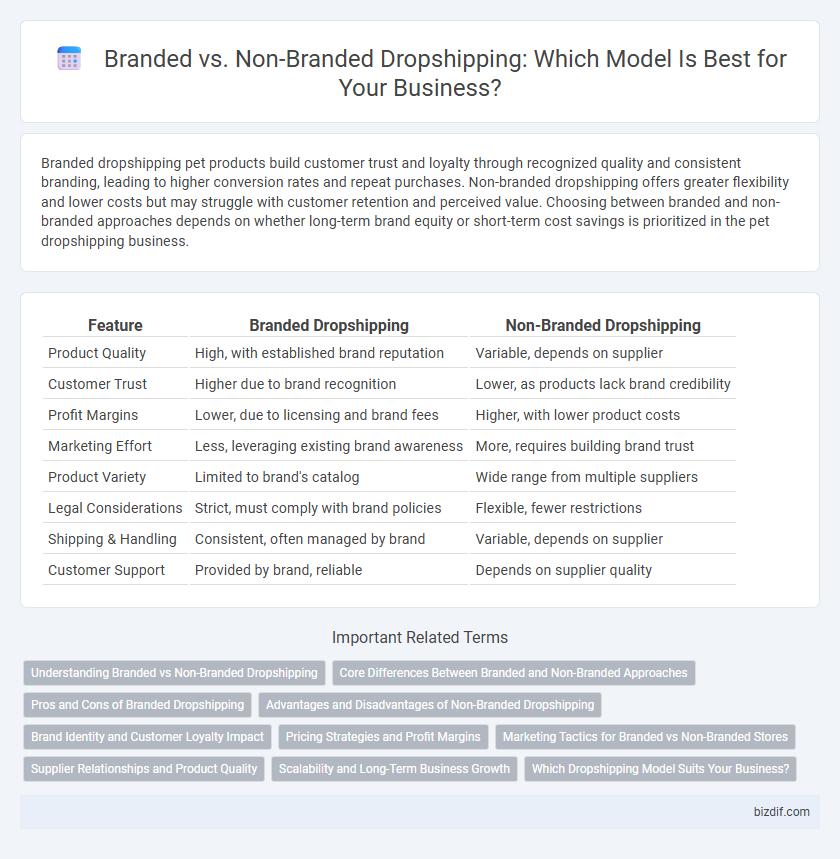Branded dropshipping pet products build customer trust and loyalty through recognized quality and consistent branding, leading to higher conversion rates and repeat purchases. Non-branded dropshipping offers greater flexibility and lower costs but may struggle with customer retention and perceived value. Choosing between branded and non-branded approaches depends on whether long-term brand equity or short-term cost savings is prioritized in the pet dropshipping business.
Table of Comparison
| Feature | Branded Dropshipping | Non-Branded Dropshipping |
|---|---|---|
| Product Quality | High, with established brand reputation | Variable, depends on supplier |
| Customer Trust | Higher due to brand recognition | Lower, as products lack brand credibility |
| Profit Margins | Lower, due to licensing and brand fees | Higher, with lower product costs |
| Marketing Effort | Less, leveraging existing brand awareness | More, requires building brand trust |
| Product Variety | Limited to brand's catalog | Wide range from multiple suppliers |
| Legal Considerations | Strict, must comply with brand policies | Flexible, fewer restrictions |
| Shipping & Handling | Consistent, often managed by brand | Variable, depends on supplier |
| Customer Support | Provided by brand, reliable | Depends on supplier quality |
Understanding Branded vs Non-Branded Dropshipping
Branded dropshipping involves selling products from well-known manufacturers, offering higher customer trust and potential for premium pricing, whereas non-branded dropshipping focuses on generic or unbranded items, often resulting in lower costs and higher competition. Understanding the differences helps entrepreneurs choose a strategy based on profit margins, marketing efforts, and customer loyalty. Branded products typically require partnerships or authorization, while non-branded inventory allows more flexibility in sourcing and pricing.
Core Differences Between Branded and Non-Branded Approaches
Branded dropshipping leverages established brand reputation and customer trust to drive sales, often allowing for higher profit margins and increased customer loyalty. Non-branded dropshipping relies on generic products with lower entry barriers but faces intense competition and typically operates with thinner margins. Core differences include brand recognition, pricing power, marketing strategies, and customer retention capabilities.
Pros and Cons of Branded Dropshipping
Branded dropshipping offers the advantage of higher customer trust, increased perceived value, and better profit margins due to established brand recognition. However, it often involves higher upfront costs, limited supplier options, and stricter compliance with brand guidelines that can restrict marketing flexibility. Choosing branded dropshipping can enhance long-term business sustainability but requires careful management of inventory, pricing, and customer expectations.
Advantages and Disadvantages of Non-Branded Dropshipping
Non-branded dropshipping offers lower startup costs and easier market entry due to no requirements for brand licensing or approval, allowing sellers to quickly test diverse products with minimal risk. However, lack of brand recognition can result in lower customer trust and reduced pricing power, leading to thinner profit margins and higher competition from numerous sellers offering similar generic products. This model also poses challenges in building customer loyalty and differentiation, making long-term business growth more difficult compared to branded dropshipping.
Brand Identity and Customer Loyalty Impact
Branded dropshipping enhances brand identity by allowing sellers to offer unique, recognizable products that build trust and differentiate from competitors, fostering stronger customer loyalty. Non-branded dropshipping often results in generic offerings that struggle to create emotional connections or repeat purchases, limiting long-term customer retention. Investing in branded dropshipping strategies significantly improves customer lifetime value by establishing consistent quality and a memorable shopping experience.
Pricing Strategies and Profit Margins
Branded dropshipping typically allows for higher pricing strategies due to the perceived value and customer trust associated with well-known brands, resulting in stronger profit margins despite potentially higher costs per product. Non-branded dropshipping relies on competitive pricing to attract price-sensitive customers, often leading to thinner profit margins driven by volume sales and lower overhead. Strategic pricing in branded dropshipping emphasizes brand premium and exclusivity, while non-branded models focus on cost efficiency and dynamic pricing to maximize market penetration.
Marketing Tactics for Branded vs Non-Branded Stores
Branded dropshipping stores leverage strong brand identity, leveraging consistent logos, unique packaging, and targeted storytelling to foster customer trust and loyalty. Marketing tactics for branded stores emphasize social proof, influencer partnerships, and premium content to differentiate in competitive markets. Non-branded dropshipping relies on aggressive price promotions, broad ad targeting, and high-volume product listings to capture impulse buyers and test niche demand rapidly.
Supplier Relationships and Product Quality
Branded dropshipping relies heavily on established supplier relationships that ensure consistent product quality and brand reputation, often involving stricter quality controls and verified certifications. Non-branded dropshipping typically involves working with a broader range of suppliers, which can lead to variability in product quality and less predictable supplier reliability. Maintaining strong communication and vetting processes with suppliers is crucial in both models to minimize risks and uphold customer satisfaction.
Scalability and Long-Term Business Growth
Branded dropshipping offers higher scalability and long-term business growth due to increased customer loyalty and premium pricing potential. Non-branded dropshipping provides faster startup but often faces saturation and margin compression, limiting sustainable expansion. Investing in brand development enhances market differentiation, repeat purchases, and overall profitability over time.
Which Dropshipping Model Suits Your Business?
Choosing between branded dropshipping and non-branded dropshipping depends on your business goals, target audience, and marketing strategy. Branded dropshipping offers higher profit margins, customer loyalty, and brand recognition by selling products under your own label, ideal for businesses seeking long-term growth. Non-branded dropshipping focuses on selling generic products with lower upfront costs and easier startup, suitable for businesses testing markets or targeting price-sensitive customers.
Branded Dropshipping vs Non-Branded Dropshipping Infographic

 bizdif.com
bizdif.com